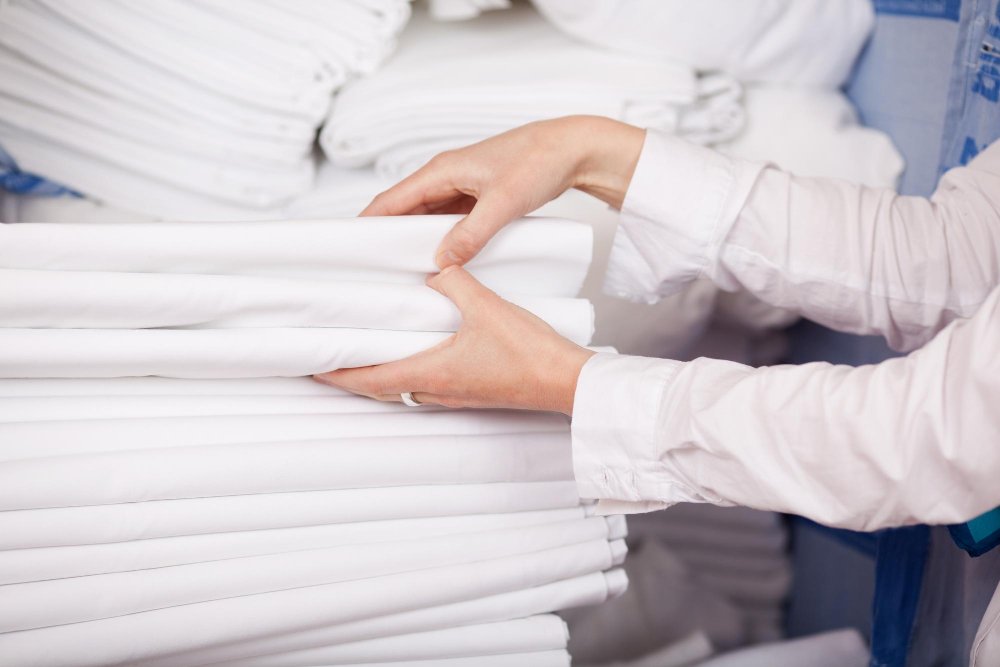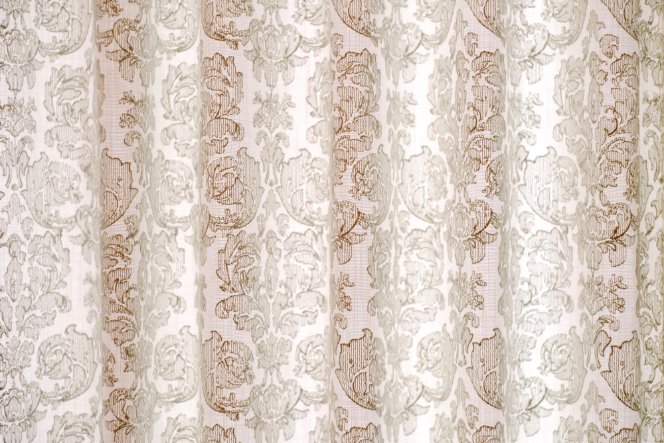Discover how linen velvet combines natural breathability with soft texture for elegant, practical interiors
Table of Contents
- What Is Linen Velvet?
- History of Linen Velvet
- Advantages of Linen Velvet
- Disadvantages and Limitations
- Linen Velvet vs. Other Velvet Types
- Understanding Durability: Martindale Ratings
- Sustainability and Environmental Impact
- Choosing the Right Linen Velvet
- Applications and Use Cases
- Care and Maintenance Guide
- Troubleshooting Common Issues
- Price Guide and Value
- Frequently Asked Questions
Interior spaces need materials that look good and work hard. Linen velvet delivers both. This textile merges the natural breathability of linen fibers with the soft, plush surface of velvet, creating a fabric that feels as good as it looks.
The combination makes sense. Linen brings durability and cooling properties, while velvet adds visual depth and comfort. Together, they create a material that suits everything from coastal homes to modern offices. The result is a fabric that breathes in warm weather, holds up to regular use, and ages with character.
Key Takeaways
- Linen velvet combines breathable linen with soft velvet texture
- Typical durability ratings range from 15,000 to 30,000 Martindale rubs
- Best suited for moderate-traffic areas and warm climates
- More sustainable than synthetic velvet options
- Requires gentler care than synthetic alternatives
- Develops attractive patina over time
What Is Linen Velvet?
Linen velvet is a woven fabric with a soft pile surface made primarily from linen fibers. Unlike traditional velvet historically made from silk, or modern versions made from synthetic materials like polyester, linen velvet uses fibers from the flax plant as its base.
Can Velvet Be Made From Linen?
Yes, velvet can definitely be made from linen. The velvet construction method works with different fiber types. Manufacturers weave two layers of fabric simultaneously on special looms, then cut them apart to create the characteristic pile. This process works with silk, cotton, wool, synthetic fibers, and linen.
Linen velvet typically contains 40-60% linen fibers blended with cotton or small amounts of synthetic materials. Pure linen velvet exists but is less common due to linen’s natural stiffness. The blends create a better balance of softness and structure.
Composition and Construction
Most linen velvet fabrics contain:
- 40-56% linen: Provides breathability, moisture-wicking, and durability
- 25-40% cotton: Adds softness and helps with dye absorption
- 0-15% polyester or other synthetics: Improves resilience and reduces wrinkling
The pile on linen velvet tends to be shorter than silk or cotton velvet, typically 2-3mm compared to 3-5mm on other types. This shorter pile creates a matte finish rather than the glossy sheen seen on silk velvet.
The texture often shows subtle striations or irregular patterns. This happens because linen threads vary slightly in thickness, creating what textile professionals call “strie.” Rather than being a defect, this natural variation adds character and visual interest to the fabric.
History of Linen Velvet
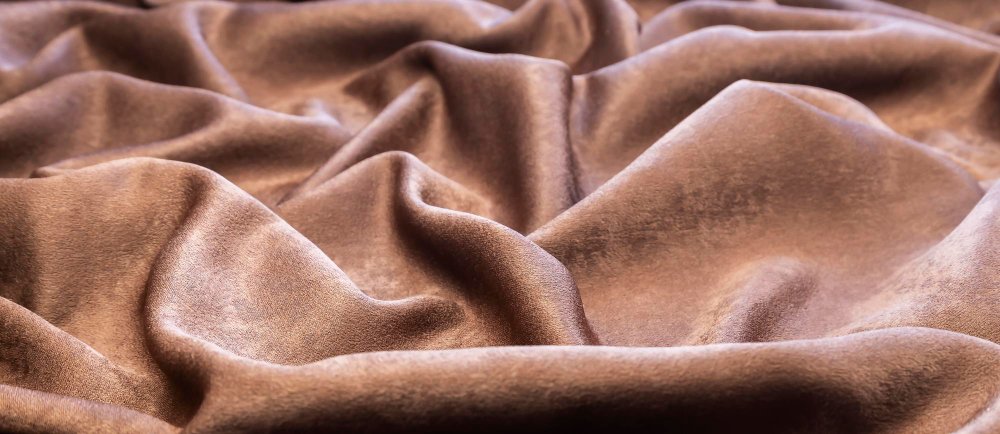
Velvet itself has ancient roots. Archaeological evidence shows silk velvet existed in China as far back as 403 BC. Early Middle Eastern cultures in Iraq and Egypt also produced velvet, making it one of humanity’s oldest luxury textiles.
European velvet production began along the Silk Road trade routes. By the 14th century, Italian cities like Venice, Genoa, Florence, and Lucca became famous for producing elaborate velvet fabrics. These textiles were so expensive that only nobility and religious institutions could afford them.
The price came from the labor-intensive production process and expensive silk fibers. Velvet required special looms and skilled weavers. A single piece could take weeks to produce.
The Democratization of Velvet
Everything changed in the 1830s when manufacturers developed “double velvet” weaving on Jacquard looms. This innovation let producers weave two velvet pieces simultaneously, cutting production time and costs in half. For the first time, middle-class households could afford velvet furnishings.
Linen velvet emerged as producers experimented with different fibers. Linen offered practical benefits: it cost less than silk, stood up better to daily use, and felt cooler to the touch. These qualities made it popular for upholstery in warmer regions and for items that needed frequent cleaning.
The fabric gained particular popularity in coastal areas and warm climates where silk velvet felt too heavy and synthetic velvet trapped too much heat. Today, linen velvet fills a niche between formal silk velvet and practical synthetic options.
Advantages of Linen Velvet
Natural Breathability
Linen fibers have a hollow structure that allows air to flow through the fabric. This makes linen velvet significantly cooler than synthetic alternatives. In warm weather or heated rooms, furniture covered in linen velvet stays comfortable rather than becoming sticky or warm to the touch.
This breathability also helps with moisture management. The fabric wicks away perspiration and humidity, then releases it into the air. This property makes linen velvet popular for summer-appropriate furnishings and homes in humid climates.
Rich, Matte Color
Linen absorbs dye exceptionally well. The fibers take color deeply and hold it with minimal fading. This creates rich, saturated tones with a soft matte finish. Unlike the shiny surface of silk velvet, linen velvet has an understated, sophisticated appearance.
The color depth changes with lighting. In bright daylight, the fabric shows its full saturation. Under softer evening light, the tones become warmer and more muted. This quality helps linen velvet work across different times of day and lighting conditions.
Unique Texture and Character
The natural variation in linen thread thickness creates visual interest. The subtle striations and texture add depth without being busy or distracting. This makes linen velvet easy to incorporate into both minimalist and layered design schemes.
Over time, the fabric develops a beautiful patina. The pile may crush slightly in high-use areas, creating a lived-in look similar to worn leather. Many designers consider this aging process an asset rather than a drawback.
Environmental Benefits
Compared to synthetic velvet, linen velvet has a smaller environmental footprint. Linen production requires less water than cotton, no pesticides when grown in ideal conditions, and the fibers are biodegradable. We’ll explore this more in the sustainability section.
Disadvantages and Limitations
Understanding linen velvet’s limitations helps set realistic expectations and avoid disappointment.
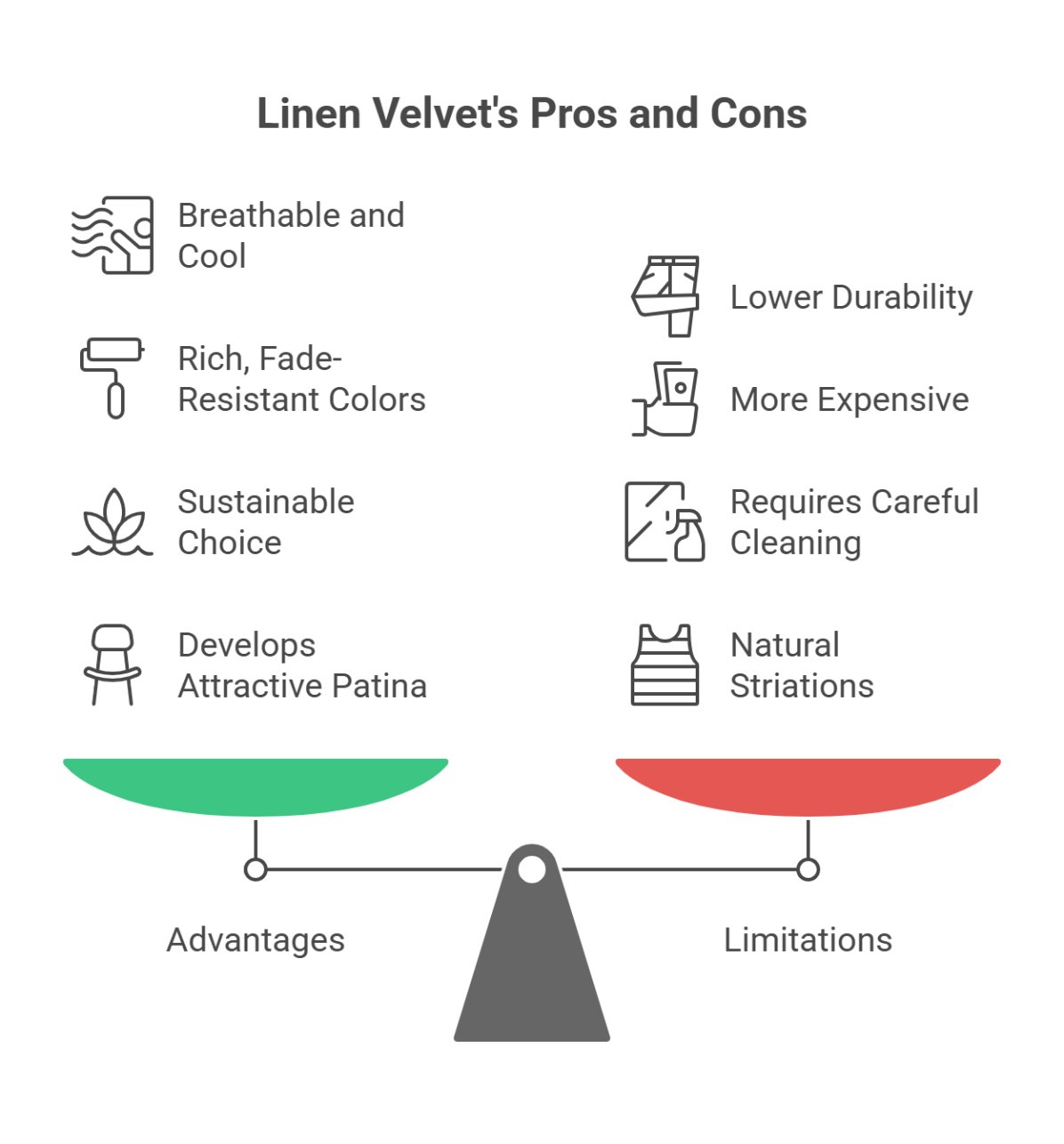
Advantages
- Naturally breathable and cool
- Rich, fade-resistant colors
- More sustainable than synthetics
- Develops attractive patina
- Unique texture with character
Limitations
- Lower durability than mohair or synthetics
- Prone to crushing and bruising
- More expensive than synthetic options
- Requires careful cleaning
- Natural striations may not suit all tastes
Lower Pile Resilience
Linen velvet has a shorter pile that’s more prone to crushing than cotton or synthetic velvet. Sitting pressure leaves marks that may take hours to bounce back. Some marks never fully recover, especially in high-use areas like sofa seats or chair arms.
This characteristic isn’t necessarily bad. Many people appreciate the aged look. However, if you want furniture that always looks pristine, synthetic performance velvet might be a better choice.
Moderate Durability
With typical Martindale ratings of 15,000 to 30,000 rubs, linen velvet sits in the middle durability range. It’s tougher than decorative silk velvet but less robust than mohair velvet (which can exceed 50,000 rubs) or high-performance synthetics (often 100,000+ rubs).
This makes linen velvet best for moderate-traffic areas. It works well on occasional chairs, bedroom furniture, or dining chairs. For family room sofas with daily use or homes with active pets, consider more durable alternatives.
Care Requirements
Linen velvet needs gentler care than synthetic fabrics. Water spots can leave marks. Harsh cleaning chemicals may damage the fibers. Professional cleaning is often recommended for serious stains.
The fabric also wrinkles more easily than synthetic velvet. While some people like this relaxed look, others find it messy. Steaming helps, but complete wrinkle removal is difficult.
Price Point
Quality linen velvet typically costs $40-120 per yard, compared to $15-40 for synthetic velvet. The natural fibers and more complex production process drive up the price.
Linen Velvet vs. Other Velvet Types
Each velvet type has distinct characteristics. Understanding these differences helps you choose the right fabric for your needs.
| Velvet Type | Durability | Maintenance | Best For | Price Range |
|---|---|---|---|---|
| Linen Velvet | 15,000-30,000 rubs | Moderate effort | Warm climates, moderate traffic | $$-$$$ |
| Silk Velvet | 10,000-15,000 rubs | High (professional cleaning) | Decorative pieces, formal spaces | $$$$ |
| Cotton Velvet | 20,000-35,000 rubs | Moderate effort | Classic styles, general use | $-$$ |
| Mohair Velvet | 50,000-100,000 rubs | Low effort | High-traffic areas, families | $$$-$$$$ |
| Synthetic Velvet | 40,000-150,000+ rubs | Very low effort | Budget, pets, heavy use | $ |
Detailed Comparisons
Linen Velvet vs. Cotton Velvet
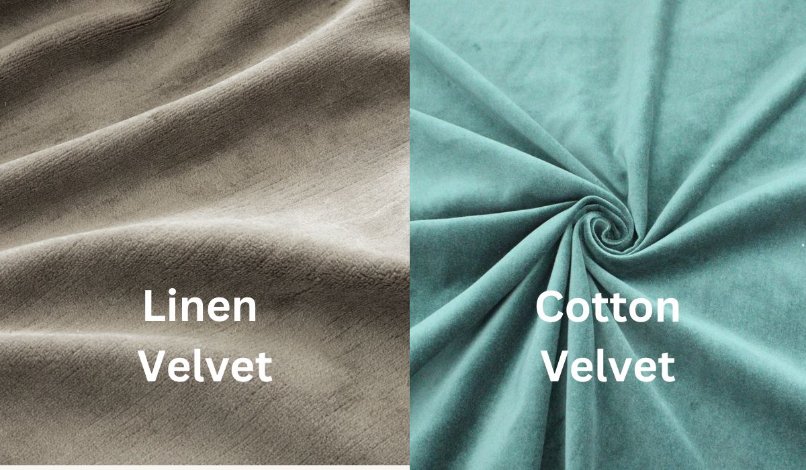
Breathability: Linen velvet stays cooler and manages moisture better than cotton velvet. This makes it preferable in warm climates or well-heated homes.
Appearance: Cotton velvet has a more uniform surface and slightly higher sheen. Linen velvet shows natural striations and has a flatter, more matte finish.
Durability: Cotton velvet often has slightly better crush resistance, especially when blended with polyester. However, both fall in the same general durability range.
Linen Velvet vs. Silk Velvet
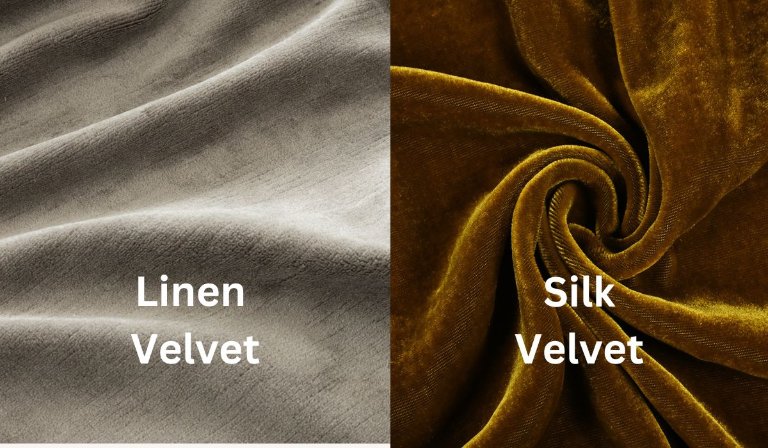
Luxury factor: Silk velvet remains the most luxurious option with its glossy sheen and incredibly soft touch. Linen velvet offers a more casual, understated elegance.
Practicality: Linen velvet handles daily use much better than silk. Silk velvet stains easily, fades in sunlight, and requires professional cleaning. Linen is significantly more forgiving.
Cost: Silk velvet costs 2-3 times more than linen velvet. Unless you need the specific look of silk for a formal, low-use piece, linen offers better value.
Linen Velvet vs. Mohair Velvet
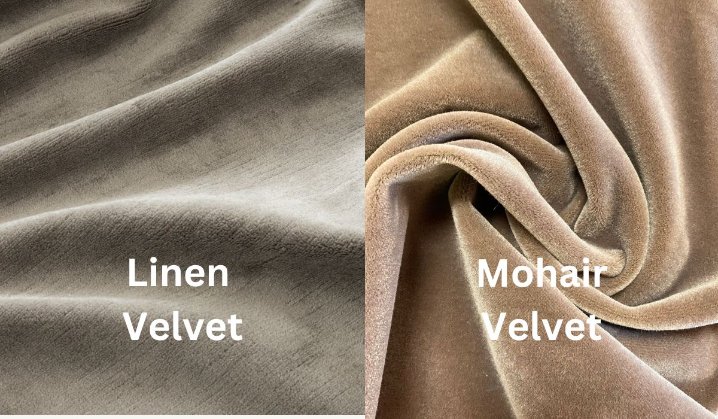
Durability: Mohair velvet wins decisively. Made from Angora goat hair, mohair resists crushing, tolerates dirt well, and stands up to heavy use. It’s the gold standard for high-traffic upholstery.
Feel: Mohair has a slightly coarser texture than linen. Linen feels softer and smoother against skin.
Climate: Linen velvet stays cooler and works better in warm weather. Mohair provides more warmth, making it better for cold climates.
Linen Velvet vs. Synthetic Velvet

Sustainability: Linen velvet has a much smaller environmental footprint. Synthetic velvet is made from petroleum-based polyester or nylon, which aren’t biodegradable and shed microplastics when washed.
Performance: Synthetic performance velvet offers superior stain resistance and durability. Many synthetic velvets have protective finishes that cause spills to bead up for easy cleaning.
Feel: Linen velvet feels more natural and breathes better. Synthetic velvet can feel plasticky and trap heat. However, high-quality synthetic velvets have improved significantly and can feel quite nice.
Understanding Durability: Martindale Ratings Explained
When shopping for linen velvet, you’ll see Martindale ratings. These numbers tell you how well the fabric will hold up to use. Understanding them helps you choose appropriately for your space.
What Is the Martindale Test?
The Martindale test measures how fabric resists abrasion. During the test, a machine rubs a piece of wool or sandpaper against the fabric in a figure-eight pattern under set pressure. The test continues until the fabric shows visible wear or breaks through.
The number you see (like “25,000 Martindale rubs”) indicates how many cycles the fabric withstood before showing damage. Higher numbers mean better durability.
Martindale Rating Guide for Different Uses
Typical Linen Velvet Ratings
Most linen velvet fabrics test between 15,000 and 30,000 Martindale rubs. The exact rating depends on:
- Fiber blend: Higher synthetic content increases durability
- Weave density: Tighter weaves last longer
- Pile height: Shorter pile (which linen velvet naturally has) can be more durable
- Finish treatments: Some manufacturers apply protective treatments
A 25,000-rub linen velvet should last 3-5 years on a moderately used sofa, longer on occasional chairs or bedroom furniture. For reference, quality mohair velvet might last 10-15 years in the same conditions.
Want to assess fabric durability for your specific needs? Try our Fabric Durability Calculator to estimate how long different materials will last based on your usage patterns.
Sustainability and Environmental Impact
In an era where environmental impact matters, linen velvet offers real advantages over synthetic alternatives. Understanding these benefits helps you make informed choices.
Why Linen Is Among the Most Sustainable Fibers
Linen comes from the flax plant, which has remarkable environmental credentials when grown in its ideal conditions (Northern Europe, particularly France, Belgium, and the Netherlands).
Water efficiency: Flax requires no irrigation in regions with adequate rainfall. The plants thrive on natural rain alone. Compare this to cotton, which needs 2,700 liters of water to produce a single t-shirt, or polyester production, which uses significant water for cooling in manufacturing.
No pesticides needed: In ideal growing conditions, flax needs no herbicides, pesticides, or fertilizers. The plant naturally resists pests and diseases. This keeps harmful chemicals out of waterways and soil. According to the Victoria and Albert Museum, when grown in ideal European conditions, flax cultivation produces no waste and requires no irrigation, fertilizers, or pesticides.
Complete plant usage: Nothing goes to waste in flax processing. Long fibers become linen textiles. Short fibers make paper or composite materials. Seeds produce linseed oil. After harvest, the root remnants naturally fertilize and improve soil quality for 6-7 years. The Alliance for European Flax-Linen and Hemp certifies sustainable European flax production through their Masters of FLAX FIBRE™ certification.
Biodegradability: At the end of its life, linen velvet breaks down naturally. Synthetic velvet made from polyester or nylon can take 200+ years to decompose in landfills.
Environmental Comparison: Linen vs. Synthetic Velvet
Production emissions: Polyester production releases significant greenhouse gases because it’s derived from petroleum. Creating virgin polyester requires extracting and processing fossil fuels. Linen production has a much smaller carbon footprint.
Microplastic pollution: Synthetic velvet sheds tiny plastic fibers every time it’s washed or even just used. These microplastics end up in waterways and oceans. Studies estimate that washing synthetic textiles releases about 500,000 tons of plastic microfibers into oceans annually. Linen velvet sheds natural fibers that break down harmlessly. For more information on velvet sustainability across different materials, see this comprehensive material guide from Good On You.
Energy use: Linen processing is mainly mechanical (crushing, combing, and spinning), which uses less energy than chemical-intensive polyester production.
Limitations of Linen Velvet’s Sustainability
Not all linen velvet is equally sustainable:
Growing location matters: Flax grown outside ideal European regions often requires irrigation, fertilizers, and pesticides. This negates many environmental benefits. Check where the linen originates.
Blended fabrics: Most linen velvet includes cotton or synthetic fibers. While a small percentage of polyester (5-15%) improves performance without major environmental harm, higher synthetic content reduces sustainability benefits.
Dyeing process: All velvet requires dyeing, which uses water and chemicals. Look for fabrics with OEKO-TEX or GOTS certifications, which verify safer dyeing practices.
Transportation: Imported textiles have a higher carbon footprint from shipping. European-made linen velvet used in Europe has a smaller impact than linen shipped globally.
What to Look For
If sustainability matters to you, seek out:
- European flax certification: Verifies the linen comes from low-impact European farms
- OEKO-TEX Standard 100: Confirms the fabric is free from harmful chemicals
- GOTS (Global Organic Textile Standard): For organic linen velvet, though this is rare
- High linen content: 50%+ linen is better than heavily blended options
Learn more about natural vs. synthetic fabrics and their environmental impacts.
Choosing the Right Linen Velvet
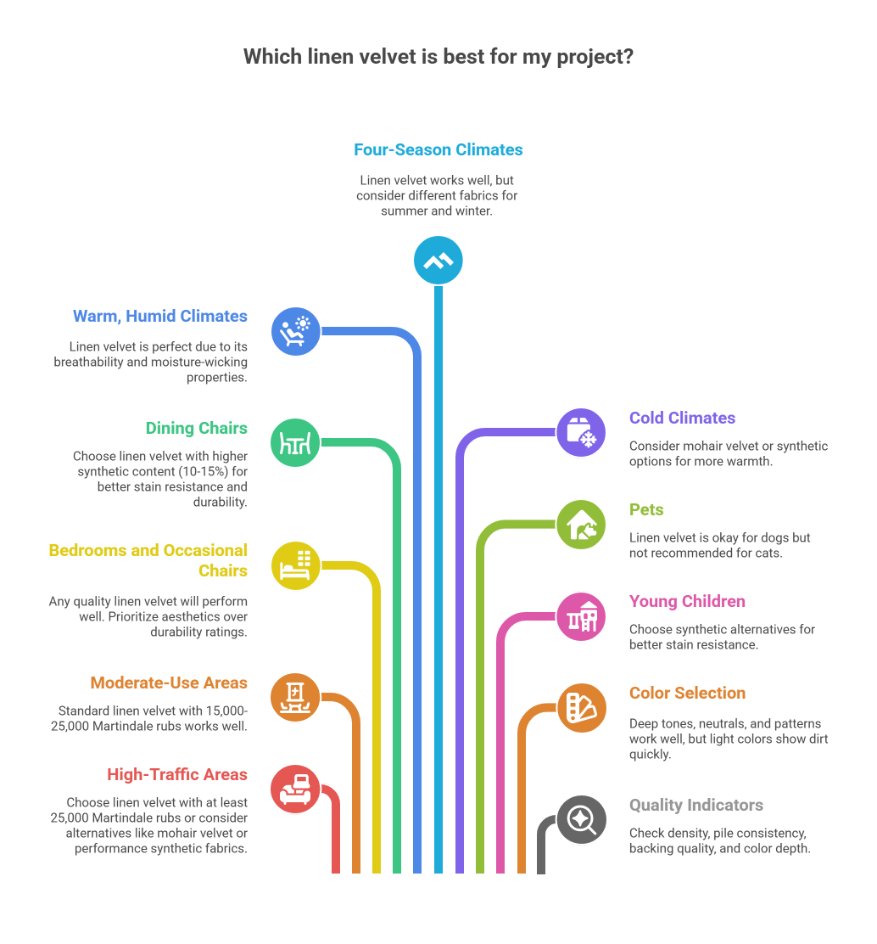
Not all linen velvet is created equal. Several factors determine whether a particular fabric will work for your project.
Consider Your Space and Usage
High-traffic family rooms: Look for linen velvet with at least 25,000 Martindale rubs or consider alternatives like mohair velvet or performance synthetic fabrics. Pure linen velvet may show wear too quickly.
Moderate-use living rooms: Standard linen velvet with 15,000-25,000 Martindale rubs works well. The fabric will develop character over time without excessive wear.
Bedrooms and occasional chairs: Any quality linen velvet will perform well. You can prioritize aesthetics over durability ratings.
Dining chairs: If you have young children, choose linen velvet with higher synthetic content (10-15%) for better stain resistance and durability.
Climate Considerations
Linen velvet shines in certain climates:
Warm, humid areas: Perfect choice. The breathability and moisture-wicking properties keep furniture comfortable year-round. This makes linen velvet popular in southern US states, coastal regions, and tropical climates.
Four-season climates: Works well, though you might want different fabrics for summer and winter pieces.
Cold climates: Consider mohair velvet or synthetic options instead. These provide more warmth and coziness in winter.
Pets and Children
Linen velvet and pets can coexist, but with caveats:
Dogs: Generally okay if your dog doesn’t scratch furniture. The natural fibers resist dog odors better than synthetics. However, the fabric can show wear from repeated jumping on/off furniture.
Cats: Not recommended. Cat claws will snag the pile. If you have cats who scratch, choose tightly woven fabrics like microfiber or leather.
Young children: Depends on messiness. Linen velvet handles light spills if cleaned immediately but stains more easily than synthetic performance fabrics. For toddlers prone to big spills, wait a few years or choose synthetic alternatives.
Color Selection
Linen velvet’s matte finish affects how colors appear:
Deep, rich tones: Forest green, navy blue, burgundy, and charcoal look stunning. The matte finish prevents these colors from feeling heavy or overly formal.
Neutrals: Beige, gray, and taupe work beautifully and hide minor marks better than light or dark extremes.
Light colors: Whites, creams, and pastels show dirt and marks quickly. Reserve these for low-use areas or formal spaces.
Patterns: The natural striations in linen velvet add visual interest, making solid colors more dynamic than they’d be on smooth fabrics. Bold patterns can compete with this texture.
Quality Indicators
When examining linen velvet samples:
Density test: Bend the fabric diagonally. You should barely see the backing through the pile. If you can easily see rows of pile fibers with lots of backing showing, the fabric is low quality.
Pile consistency: Run your hand across the surface. High-quality linen velvet has even pile height despite the natural striations. Large bald patches or very uneven pile indicate poor manufacturing.
Backing quality: Flip the sample over. The backing fabric should be tightly woven and substantial. Loose or thin backing means the pile won’t stay secure.
Color depth: Quality linen velvet has rich, saturated color that looks the same from all angles. Poor dyeing results in patchy or faded-looking sections.
Use our Fabric Identification Quiz to test your knowledge and learn more about quality indicators.
Applications and Use Cases

Upholstery
Linen velvet excels on certain furniture pieces:
Armchairs and accent chairs: Perfect application. These pieces get moderate use, and linen velvet’s texture adds sophistication without requiring the durability of family room sofas.
Dining chairs: Good choice if you clean spills promptly. The breathability helps during long dinners. Consider darker colors or patterns to hide minor marks.
Headboards: Excellent use. The soft texture feels pleasant to lean against, and headboards experience minimal wear. The fabric’s natural striations add visual interest to the bedroom.
Sofas: Works for low-traffic living rooms or adult households. For family rooms with daily use, choose linen velvet with higher durability ratings (25,000+ Martindale rubs) or consider alternatives.
Ottomans and footstools: Great choice. These pieces get regular contact but less grinding wear than chair seats.
Drapery and Curtains
Linen velvet makes stunning window treatments. The matte finish and rich color create depth without the heavy formality of silk velvet. The fabric drapes beautifully, creating soft folds rather than stiff pleats.
Best applications:
- Living room and bedroom curtains
- Room dividers
- Theater or media room drapes (the fabric absorbs sound)
Considerations: Use curtain lining to protect against sun damage. Direct sunlight will fade any natural fiber over time. Linen velvet curtains need more careful handling than synthetic options when cleaning.
Can I Mix Velvet and Linen?
Yes, mixing linen velvet with other linen textures creates beautiful, layered interiors. The combination works because both materials share similar casual-elegant qualities and natural origins.
Successful combinations:
Linen velvet sofa with linen throw pillows: The texture contrast adds interest while the common fiber type keeps the look cohesive. Try smooth plain weave linen pillows or loose weave linen for maximum contrast.
Linen velvet curtains with linen sheeting: Velvet curtains add luxury, while linen sheeting or cambric linen provides softness for bedding or table linens.
Mixed furniture: A linen velvet armchair pairs beautifully with a sofa in flat linen upholstery. The velvet becomes the statement piece while the plain linen grounds the space.
Design tips:
- Keep colors in the same family (all neutrals or all jewel tones)
- Use velvet as the accent, not the dominant fabric
- Balance the soft pile of velvet with crisper linen textures
- Consider damask linen for subtle pattern contrast
Accent Pieces
Beyond major furniture and window treatments:
Throw pillows: Add instant luxury to sofas or beds. Mix linen velvet pillows with other textures like bouclé or smooth cotton.
Bench cushions: Perfect for entry halls or bedroom benches. The soft seating welcomes guests and adds color.
Wall panels: Acoustic wall panels covered in linen velvet absorb sound while adding visual warmth. Good for home offices or media rooms.
Commercial Spaces
Linen velvet can work in commercial settings with appropriate expectations:
Suitable spaces:
- Boutique hotel guest rooms (not public areas)
- Restaurant booths in upscale, low-traffic sections
- Office reception areas with moderate traffic
- Retail dressing rooms and seating areas
Not recommended for:
- Hotel lobbies or other high-traffic public areas
- Fast-casual restaurants
- Waiting rooms in medical offices
- Conference centers
For heavy commercial use, specify mohair velvet or performance synthetic fabrics with 40,000+ Martindale rubs.
Care and Maintenance Guide
Proper care keeps linen velvet looking good for years. The natural fibers need gentler treatment than synthetic alternatives, but the process isn’t difficult.
Regular Maintenance
Weekly dusting: Use a soft brush attachment on your vacuum. Vacuum in the direction of the pile (not against it) using low suction. This removes dust and lint before they settle into the fibers.
Fluffing the pile: Gently brush the fabric weekly with a soft-bristle brush or velvet brush. This revives crushed areas and keeps the pile looking fresh. Always brush in the direction of the pile.
Rotate cushions: If possible, flip and rotate cushions every few weeks. This distributes wear evenly and prevents permanent crushing in high-use spots.
How to Clean Linen Velvet
Different situations require different approaches:
-
Fresh Liquid Spills
Act immediately. Blot (don’t rub) with a clean, dry cloth or paper towel. Work from the outside of the spill toward the center to prevent spreading. Continue blotting with fresh sections of cloth until no more liquid transfers.
-
Water-Based Stains
After blotting up excess liquid, dampen a clean white cloth with cool water. Blot the stain gently. Don’t scrub or rub, as this damages the pile. Continue with fresh dampened cloths until the stain lightens. Let air dry completely, then brush the pile gently.
-
Greasy or Oil-Based Stains
Sprinkle cornstarch or baking soda on the stain immediately. Let it sit for 15-20 minutes to absorb the oil. Vacuum away the powder using low suction. If any stain remains, call a professional upholstery cleaner.
-
Stubborn Stains
Mix one teaspoon of gentle, pH-neutral detergent (like baby shampoo or wool wash) with one cup of cool water. Dip a white cloth in the solution and wring it nearly dry. Blot the stain gently. Follow with a clean, damp cloth to remove detergent residue. Air dry and brush.
How to Wash Velvet Linens
Most linen velvet upholstery can’t be machine washed, but removable cushion covers sometimes can. Check the care label first.
If machine washing is approved:
- Use cold water and gentle cycle
- Choose a mild, pH-neutral detergent
- Wash inside-out if possible
- Don’t overload the machine
- Remove promptly when done
Drying: Never put linen velvet in a dryer. The heat crushes the pile permanently. Instead, lay flat on a clean towel or hang on a padded hanger to air dry. Keep away from direct sunlight or heat sources.
Hand washing: For small items like pillow covers, fill a basin with cool water and mild detergent. Gently swish the item for a few minutes. Rinse thoroughly with cool water. Press out water gently (don’t wring or twist). Lay flat to dry.
How to Preserve Velvet Fabric
Long-term preservation keeps linen velvet looking good:
Sunlight protection: UV rays fade natural fibers. Position furniture away from windows with direct sun, or use UV-filtering window treatments. If sun exposure is unavoidable, expect gradual fading and rotate furniture regularly for even aging.
Humidity control: Linen naturally manages moisture, but extreme humidity or dryness isn’t ideal. Maintain 40-60% humidity in your home if possible. Too dry, and the fibers become brittle. Too humid, and mildew becomes a risk.
Storage: If storing linen velvet items, wrap them in clean cotton sheets (not plastic, which traps moisture). Store in a cool, dry place. Check periodically for pests, which can damage natural fibers.
Professional cleaning: Have upholstered pieces professionally cleaned every 1-2 years, or as needed. Professional cleaners have equipment and products designed for delicate fabrics. Make sure they have experience with velvet specifically.
For more detailed fabric care instructions, explore our comprehensive guide to washing and caring for different fabrics or use our Fabric Care Calculator for personalized recommendations.
Looking for more specialized guidance? Check out this detailed guide on caring for velvet material for additional tips and techniques.
What Not to Do
Avoid these common mistakes:
- Don’t use heat: No hair dryers, irons, or hot water. Heat can permanently damage the pile.
- Don’t rub stains: Rubbing pushes stains deeper and crushes the pile.
- Don’t use harsh chemicals: Bleach, strong detergents, and solvent-based cleaners damage natural fibers.
- Don’t saturate the fabric: Too much water causes water marks and can weaken the backing.
- Don’t use stiff brushes: Metal or hard-bristle brushes damage the pile. Stick with soft brushes designed for velvet.
Troubleshooting Common Issues
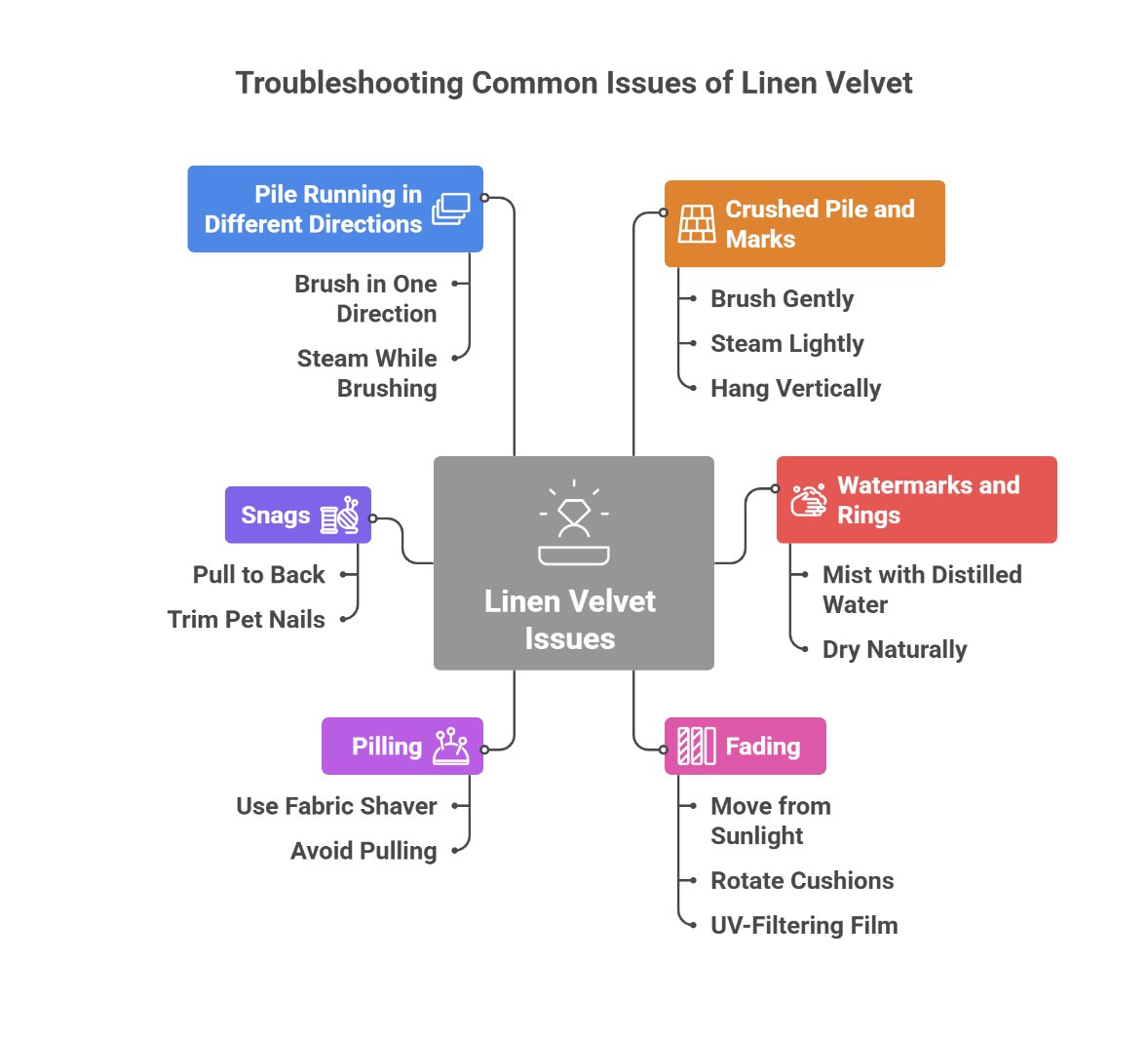
Crushed Pile and Marks
Problem: Furniture shows marks from sitting, and the pile stays flattened.
Solutions:
- Brush gently with a soft velvet brush to lift the pile
- Hold a steamer 6-8 inches away and steam the area lightly (don’t touch the fabric with the steamer head)
- Hang cushions vertically overnight to let gravity help the pile recover
- Accept that some crushing is normal and adds to the fabric’s character
Watermarks and Rings
Problem: Cleaning left circular water marks or dark rings.
Solutions:
- Lightly mist the entire cushion or panel with distilled water using a spray bottle
- Let it dry naturally and evenly
- This often eliminates the ring by evening out the moisture distribution
- For persistent marks, call a professional
Fading
Problem: Fabric has faded unevenly from sun exposure.
Solutions:
- Prevention is better than cure. Move furniture away from direct sunlight.
- Rotate cushions regularly for even fading
- Install UV-filtering window film or use curtains during peak sun hours
- Once faded, color can’t be restored. Consider reupholstering or using throws to cover affected areas
Pilling
Problem: Small balls of fiber appear on the surface.
Solutions:
- Use a fabric shaver or sweater stone to gently remove pills
- Don’t pull pills off with fingers, as this can create more
- Pilling often decreases after the first few months as loose fibers work free
Snags
Problem: A thread has pulled loose, creating a visible snag.
Solutions:
- Never cut snags
- Use a needle to pull the snagged thread to the back side of the fabric
- If the snag is significant, contact a professional upholstery repair service
- Keep pets’ nails trimmed to prevent future snags
Pile Running in Different Directions
Problem: The fabric looks patchy because the pile faces different directions.
Solutions:
- This is often normal, especially with natural linen striations
- Brush the entire surface in one direction with a soft brush
- Light steaming while brushing can help reset the pile direction
- Some variation adds to the fabric’s unique character
Price Guide and Value Considerations
Understanding the cost helps you budget appropriately and recognize fair pricing.
Typical Price Ranges Per Yard
What Affects Price
Linen content: Higher percentages of linen cost more. Pure linen velvet is rare and expensive. Most affordable options contain 30-40% linen with cotton and synthetic fillers.
Origin: European-made linen velvet (especially using European flax) typically costs more than Asian-manufactured alternatives. However, it often has better quality and sustainability credentials.
Weave density: Tighter weaves require more material and time to produce. They also last longer, justifying the higher price.
Treatments: Stain-resistant finishes, wrinkle treatments, or special dyeing processes add to the cost.
Brand: Designer brands charge premium prices. Sometimes you’re paying for design aesthetics and exclusivity rather than better quality.
Cost Comparison: Materials Needed
Fabric is typically 54-60 inches wide. Here’s what you’ll need for common projects:
- Dining chair seat: 1-1.5 yards ($30-180 depending on quality)
- Armchair: 6-8 yards ($180-960)
- Small loveseat: 12-14 yards ($360-1,680)
- Standard sofa: 14-18 yards ($420-2,160)
- Curtain panels (pair, 84″ long): 6-8 yards ($180-960)
These estimates include fabric for the main upholstery plus some waste. Always order 10-15% extra for pattern matching and errors.
Value Assessment: Is It Worth the Cost?
Linen velvet costs more than synthetic alternatives but less than silk or mohair velvet. Here’s how to think about value:
Compared to synthetic velvet: You’ll pay 2-3 times more for linen velvet. In return, you get better breathability, more sustainable materials, and a unique aesthetic. Worth it if these factors matter to you. Not worth it if you need maximum durability or stain resistance.
Compared to cotton velvet: Prices are similar, with linen velvet averaging 10-20% more. The upgrade makes sense if you live in a warm climate or value the distinctive linen texture.
Compared to silk velvet: Linen velvet costs 30-50% less while being much more practical. It’s the better choice unless you specifically want silk’s glossy luxury for a decorative piece.
Compared to mohair velvet: Prices overlap significantly. Mohair wins on durability; linen wins on breathability. Choose based on your climate and traffic levels.
Getting the Best Value
- Order samples before committing ($5-15 typically). Colors and textures vary significantly between brands.
- Check for sales at fabric stores. Upholstery fabrics often go on sale seasonally.
- Consider remnants for small projects like pillows or ottomans.
- Calculate total project cost including professional upholstery labor if needed ($300-800+ for a chair, $1,200-2,500+ for a sofa).
- Factor in longevity. A $80/yard fabric that lasts 5-7 years costs less over time than a $30/yard fabric that needs replacing in 2 years.
Use our Fabric Cost Calculator to compare total ownership costs of different materials.
Frequently Asked Questions
Linen velvet is made primarily from flax plant fibers (linen), typically blended with cotton and sometimes small amounts of polyester. Most linen velvet contains 40-56% linen, 25-40% cotton, and 0-15% synthetic fibers. The blend balances linen’s breathability and durability with cotton’s softness and synthetic fibers’ resilience.
Linen velvet works well for moderate-traffic sofas in adult households or low-traffic spaces. It’s particularly good in warm climates due to its breathability. However, for heavily used family room sofas or homes with young children or pets, consider more durable options like mohair velvet or performance synthetic fabrics. Look for linen velvet with at least 25,000 Martindale rubs if using on a main sofa.
Linen velvet typically rates 15,000 to 30,000 Martindale rubs, placing it in the moderate durability range. This means it handles regular residential use well but isn’t as tough as mohair velvet (50,000+ rubs) or synthetic performance fabrics (100,000+ rubs). With proper care, quality linen velvet should last 3-7 years on furniture that gets daily use, longer on occasional pieces.
Most linen velvet upholstery should not be machine washed. For cleaning, spot-treat stains with a slightly damp cloth and mild detergent, blotting gently rather than rubbing. Some removable cushion covers may be machine washable if the care label allows it. Use cold water, gentle cycle, and air dry flat. Never put linen velvet in a dryer, as heat permanently crushes the pile.
Yes, linen velvet is among the more sustainable upholstery options. Linen (flax) requires minimal water, no pesticides in ideal growing conditions, and is biodegradable. The flax plant improves soil quality and uses all parts of the plant with zero waste. This makes linen velvet more environmentally friendly than synthetic velvet made from petroleum-based polyester or nylon. Look for European flax certification and OEKO-TEX standards for the most sustainable options.
Yes, linen velvet wrinkles more easily than synthetic velvet due to its natural linen content. However, many people appreciate this lived-in look as part of the fabric’s character. To minimize wrinkles, avoid folding the fabric. For removing wrinkles, use a steamer held 6-8 inches away from the fabric. Never use a direct iron on linen velvet, as heat can permanently damage the pile.
The main differences are breathability, appearance, and feel. Linen velvet is more breathable and stays cooler, making it better for warm climates. It has a matte finish with natural striations, while cotton velvet has a more uniform surface and slight sheen. Cotton velvet crushes more easily but often has better pile recovery. Both fall in similar durability ranges (15,000-30,000 Martindale rubs). Linen velvet typically costs 10-20% more than cotton velvet.
Linen velvet typically costs $30-120 per yard depending on quality, with most mid-range options in the $50-80 range. Budget linen velvet with lower linen content starts around $30-50 per yard. Premium designer linen velvet can reach $120-200+ per yard. This makes it more expensive than synthetic velvet ($15-40/yard) but less than silk velvet ($150-400+/yard).
Yes, linen velvet is an excellent choice for warm climates. The natural linen fibers are highly breathable and wick moisture away from the body. This keeps furniture comfortable even in hot, humid conditions. Linen velvet stays cooler to the touch than synthetic velvet or even cotton velvet. It’s particularly popular in southern US states, coastal regions, and tropical areas.
No, linen velvet is not suitable for outdoor use. The natural fibers will deteriorate when exposed to weather, UV rays, and moisture. Outdoor furniture requires specially treated synthetic fabrics designed to resist water, sun damage, and mildew. Use linen velvet only for indoor applications or in covered, protected outdoor spaces that stay completely dry.
Conclusion
Linen velvet occupies a sweet spot in the world of upholstery fabrics. It delivers the soft, luxurious feel of velvet while bringing the practical benefits of linen: breathability, natural sustainability, and a unique aesthetic that improves with age.
This fabric isn’t the right choice for every situation. Families with young children or active pets should consider more durable alternatives. High-traffic commercial spaces need tougher materials. And anyone wanting pristine-looking furniture that never shows marks would be happier with performance synthetics.
But for the right applications, linen velvet shines. It transforms moderate-use furniture into statement pieces. The breathability makes it comfortable in warm climates where other velvets feel stuffy. The natural fibers offer a more sustainable option than petroleum-based synthetics. And the way it ages, developing character rather than just wear, appeals to people who value authenticity over perfection.
Key Takeaways for Success
Match the fabric to your lifestyle. Be honest about how much traffic your furniture gets. A 15,000 Martindale rating works fine for guest rooms but won’t hold up on the main family sofa.
Consider your climate. Linen velvet really excels in warm, humid areas. If you live where winters are long and cold, mohair velvet might serve you better.
Invest in quality if you’re committed. The difference between budget and mid-range linen velvet is significant. The extra $20-30 per yard gets you better durability, richer colors, and more linen content.
Plan for care from the start. Set yourself up for success with the right tools: a soft velvet brush, access to a steamer, and knowledge of what to do when spills happen. Don’t wait for a crisis to figure out care.
Embrace the patina. If you love furniture that looks brand new forever, linen velvet will frustrate you. But if you appreciate materials that tell a story and gain character over time, you’ll love how this fabric ages.
Order samples. Colors and textures vary dramatically between brands and dye lots. Spend $10-20 on samples to see the fabric in your lighting and next to your other furnishings. This small investment prevents expensive mistakes.
Making the Final Decision
Linen velvet works beautifully when expectations align with reality. It’s a moderate-durability, high-comfort fabric that brings natural elegance to interiors. It won’t outlast mohair velvet or stay as pristine as synthetic performance fabrics. But it offers something those materials can’t: the unique combination of cooling comfort, environmental responsibility, and authentic texture that only natural linen can provide.
For designers and homeowners who value these qualities and can work within the fabric’s limitations, linen velvet delivers a sophisticated look that improves rather than degrades with time. That’s worth considering in a world full of materials engineered to stay perfect but ultimately feel soulless.
Choose linen velvet when you want furniture that feels as good as it looks, that breathes with you through warm summer evenings, and that becomes more beautiful precisely because it shows the marks of being lived with. That’s not a compromise, it’s a different kind of perfection.


